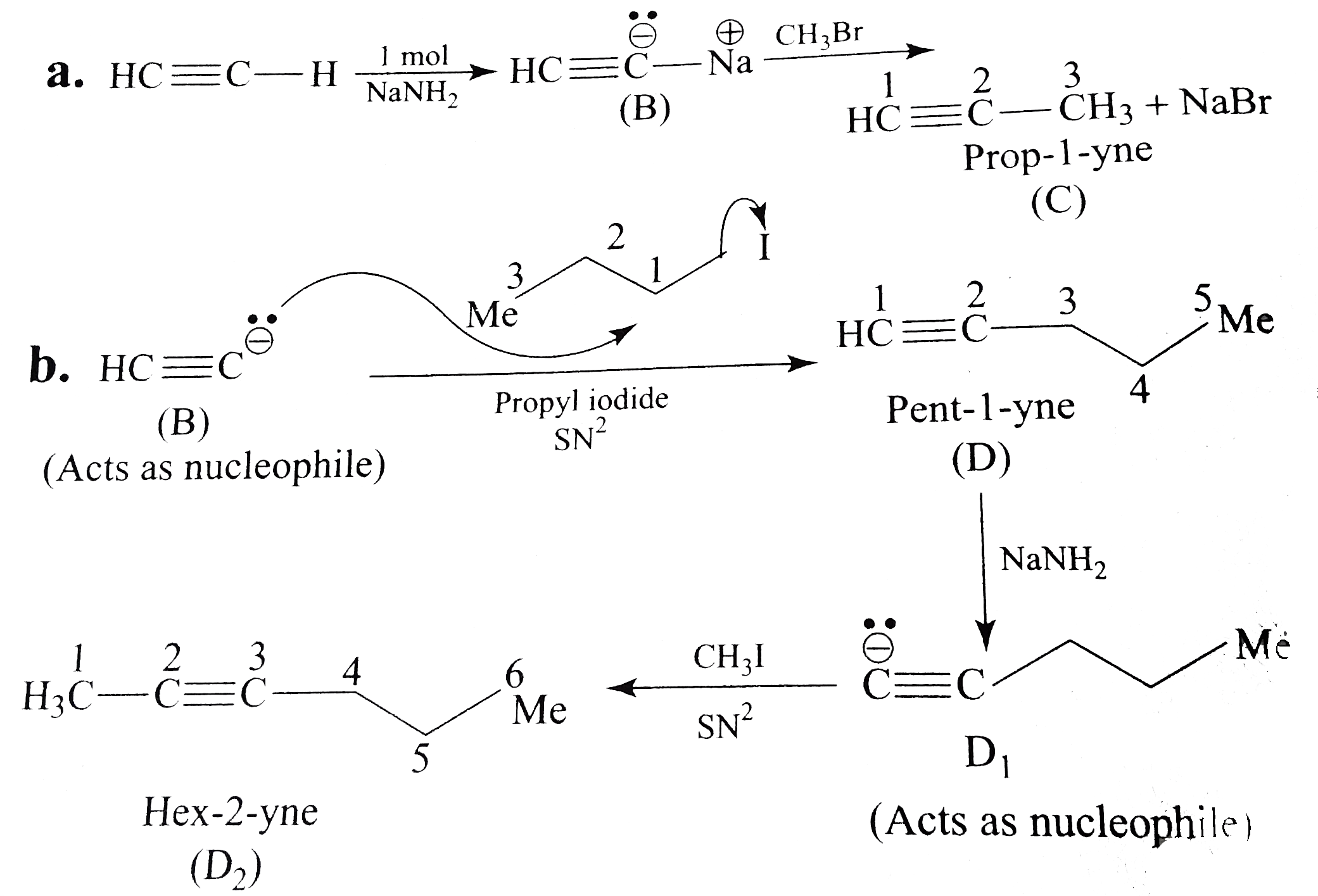Complete the following reactions: a. H−C(A)≡C−H1mol−−−−→NaNH2(B)CH3Br−−−→(C)

g. H−C≡C(A)−H1mol−−−−→NaNH2(B)Br(CH2)8Br−−−−−−−−→(C)

a. HC≡C−H1mol−−−−→NaNH2HC≡..ΘC(B)−⊕NaCH3Br−−−→1HC≡2C−3CH3+NaBrProp−1−yne(C)
b. 
With RI and RBr,SN2 reaction is dominant because Iɵ and Brɵ are better leaving groups. But Iɵ is a better leaving group than Brɵ. So with RI the reaction is faster than with RBr.
c. With RCI, E2 reaction is dominant over SN2 reaction.
CIɵ is a poor leaving group than either Brɵ or Iɵ.
Moreover, CIɵ is a better acid-strengthening group than Brɵ or Iɵ, which facilitates the removal of β-proton from the alkyl halid. Furthermore, alkynides are powerful bases but mild nucleophiles.

d. 
e. HC≡C..Θ(B)D2O−−→HC≡CD1−d−ethyne or1−Deuterio-ethyne(G)
f. HC≡CH2mol−−−−−→ofNaNH2..ΘC≡..ΘC(B1)EthyndianionD2O−−→D−C≡C−D(H)1,2−Di−d−ethyneor1,2−Dideuterio-ethyne
g. 
First reaction, i.e., alkylation of acetylide, occurs with difficulty. The second alkylation giving rings is again difficult. Intramolecular cyclisation leading to rigs with more than six C atoms is difficult and the intermolecular reaction predominates.
If a very dilute solution of NaNH2 is used, then intramolecular cyclisation takes place, thereby making it difficult for two molecules to collide to give the intermolecular alkylation.
Intermolecular alkylation:

Topper's Solved these Questions
- ALKYNESBOOK - CENGAGE CHEMISTRY ENGLISHCHAPTER - ALKYNESEXERCISE - Solved Examples
24 Videos
- ALKYNESBOOK - CENGAGE CHEMISTRY ENGLISHCHAPTER - ALKYNESEXERCISE - Exercises (Subjective Type)
31 Videos
- ALKENES AND ALKADIENESBOOK - CENGAGE CHEMISTRY ENGLISHCHAPTER - ALKENES AND ALKADIENESEXERCISE - Single correct Answer
14 Videos
- APPENDIX - INORGANIC VOLUME 1BOOK - CENGAGE CHEMISTRY ENGLISHCHAPTER - APPENDIX - INORGANIC VOLUME 1EXERCISE - chapter-7 Single correct answer
1 Videos
Similar Questions
Complete the following reaction CH3−C∣CH3=CH−CH3H2,Ni−−−→?
View SolutionComplete the following reactions:
2Me3C−−Br Ag2CO3−−−−→Δ (A)
View SolutionComplete the following reactions
CH3CH=CH2mCPBA−−−−→AC2H5MgBr−−−−−−→H3O+B
View SolutionCH3−C≡C−HNaNH2−−−−→CH31−−→Li/Liq.NH3−−−−−−−→
View SolutionComplete the following reaction sequence :
CH3−O∣∣C−CH3(i)CH3MgBr−−−−−−−−→(ii)H2O(A)Na metal−−−−→ether(B)CH3−Br−−−−−→(C)
View SolutionComplete the following reaction sequence :
CH3−O∣∣C−CH3(i)CH3MgBr−−−−−−−−→(ii)H2O(A)Na metal−−−−→ether(B)CH3−Br−−−−−→(C)
View SolutionWrite the product formed in the following reaction :
Ph−CH3∣C∣OH−C∣OHH−C∣OHH−CH3∣CH−CH2OHHIO4(excess)−−−−−−−−→
View SolutionIn the reaction CH3−C≡C−H(i)NaNH2/NH3(l)−−−−−−−−−−−−−→(A)CH3−CH2−CH2−Br−−−−−−−−−−−−−→(B) The product B is
View SolutionComplete the following reaction:
o−HOOC(A)−C6H4−CH2−PhSOCl2−−−→(B)
Anhyd−−−−−−−−−→AlCl3,CH3Cl(C)Zn+Hg−−−−−−−→+HCl(D)
View Solutioncomplete the following reactions:
a. C6H6+MeCOCIBenze≠(A) AICI3−−−→ B HNO3––––––H(2)SO4)→ C NaBH4−−−−→ D H2SO4−−−→Δ E
View Solution
